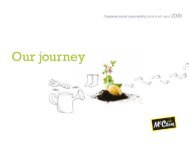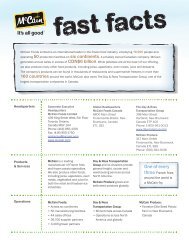From the Ground Up - McCain Foods Limited
From the Ground Up - McCain Foods Limited
From the Ground Up - McCain Foods Limited
You also want an ePaper? Increase the reach of your titles
YUMPU automatically turns print PDFs into web optimized ePapers that Google loves.
Basil Hargrove, CEO,<br />
Asia Pacific, 2006.<br />
put an end to what <strong>the</strong> Australians called “<strong>the</strong> big dry.”<br />
Meanwhile, <strong>McCain</strong>’s agronomists were developing<br />
programs to encourage growers to adopt potato varieties<br />
less susceptible to growing disorders and early maturing<br />
caused by dry spells. The <strong>McCain</strong> agronomists<br />
were also pushing for enhanced irrigation systems.<br />
<strong>McCain</strong> employees were reminded of <strong>the</strong> drought every<br />
time <strong>the</strong>y passed Lake Wendouree, site of <strong>the</strong> rowing<br />
competition in <strong>the</strong> 1956 Melbourne Olympics. The<br />
lake, in Ballarat’s most prestigious residential area, was<br />
bone dry.<br />
“The Central Highlands of Australia [where Ballarat<br />
is located] are a very good potato growing area, but <strong>the</strong>se extreme drought conditions<br />
are of great concern to us,” says Dan Dawkins, a New Brunswick native who,<br />
after working for <strong>McCain</strong> in Canada and Europe, became technical services manager<br />
for <strong>McCain</strong> Australia. “Water is becoming scarce, and we will have to adapt.” Luckily<br />
for <strong>McCain</strong>, <strong>the</strong> water shortage is less severe in Tasmania and, as of 2007, still nonexistent<br />
in New Zealand.<br />
The growth of quick-service chains in Australia was about ten years behind that of<br />
North America. These outlets did not start to proliferate until <strong>the</strong> late 1970s, just<br />
as <strong>the</strong> Ballarat plant had overcome its teething problems and was producing highquality<br />
french fries. <strong>McCain</strong> had no quick-service business in <strong>the</strong> late 1970s. By<br />
1992, it was a major supplier to almost all Australian quick-service restaurants.<br />
Long before <strong>the</strong> U.S.–based chains came along, Australia had an abundance of<br />
individually owned takeaway restaurants and fish-and-chip shops. They don’t do as<br />
much business as a McDonald’s, which sells at least ten times as many chips as a fishand-chip<br />
shop, but <strong>the</strong>re are so many of <strong>the</strong>m that it was worth <strong>McCain</strong>’s while to try<br />
to get <strong>the</strong>ir business. It has succeeded.<br />
<strong>McCain</strong> is <strong>the</strong> market leader in <strong>the</strong> Australian food service industry. It’s <strong>the</strong> result,<br />
says Yung, of simple perseverance – a large sales force making thousands of cold calls<br />
on thousands of restaurants. “It’s good old-fashioned hard selling, and we’ve kept at<br />
it,” he says.<br />
<strong>McCain</strong>’s expertise in french fry technology has been a major reason for its success<br />
in Australia’s diverse food service industry. In <strong>the</strong> field of<br />
french fries, one size definitely does not fit all. “There are<br />
a lot of different cuts,” explains Clements. “The fast food<br />
chains all have <strong>the</strong>ir own specifications. McDonald’s in<br />
particular is very strict about its specifications being met.<br />
But apart from <strong>the</strong> specifications of <strong>the</strong> fast food chains,<br />
<strong>the</strong>re are all sorts of things you can do with french fries.”<br />
To try to appeal to as many of Australia’s ten thousand<br />
takeaway and fish-and-chip shops as possible, <strong>McCain</strong> offers<br />
fries in several thicknesses, from shoestring to chunky.<br />
The shoestring chip is <strong>the</strong> crispest since its outer surface<br />
– <strong>the</strong> part that crisps – is a high percentage of <strong>the</strong> total<br />
chip. A thick chip is not as crisp since <strong>the</strong> outer surface is only a small percentage of<br />
<strong>the</strong> total chip. The thick chip, however, has a stronger potato flavour because <strong>the</strong> frying<br />
oil doesn’t impregnate all of <strong>the</strong> potato, as it does with a thin chip.<br />
Ano<strong>the</strong>r difference is <strong>the</strong> cut: crinkle or straight. “In <strong>the</strong> early days,” recalls<br />
Clements, “crinkle cut was all <strong>the</strong> rage because it was different. It was something<br />
you could get with a frozen chip that you couldn’t get at home. Now crinkle cuts are<br />
looked at as old-fashioned and <strong>the</strong> majority of <strong>McCain</strong>’s fries are straight cut.”<br />
The off-cuts – what’s left over after <strong>the</strong> fries have been cut – are also put to good<br />
use. They are mashed up, shaped, and fried into various specialty products with such<br />
names as Potato Gems, Potato Cakes, and Potato Tops, for <strong>the</strong> retail market.<br />
New Zealand is one of <strong>the</strong> world’s most beautiful countries, but Steve Yung didn’t<br />
get much chance to enjoy <strong>the</strong> scenery after being assigned <strong>the</strong>re by <strong>McCain</strong> <strong>Foods</strong> in<br />
1994. He had been working in Florenceville as group product manager when he was<br />
appointed marketing manager for New Zealand.<br />
“Our furniture had barely arrived in New Zealand when I was made vice-<br />
president of marketing for Canada back in Florenceville,” Yung recalls. “In fact, our<br />
house in New Brunswick never sold, and we just put our paintings back in <strong>the</strong> same<br />
places <strong>the</strong>y had been. For a time in 1994 and 1995, we lived for about thirty weeks<br />
without our household items because of moving from Canada to New Zealand and<br />
<strong>the</strong>n back again. Once we were back in Canada, we had to borrow camping cots<br />
and kitchen utensils.”<br />
118 <strong>From</strong> <strong>the</strong> <strong>Ground</strong> up<br />
down under 119<br />
Lake Wendouree suffering<br />
from “<strong>the</strong> big dry.”






